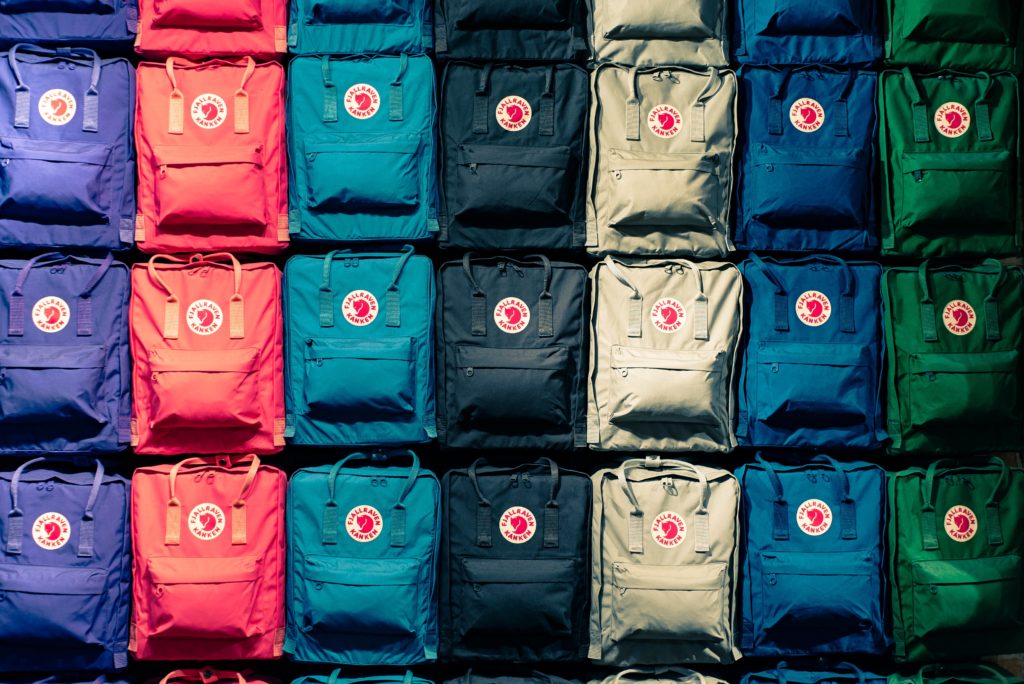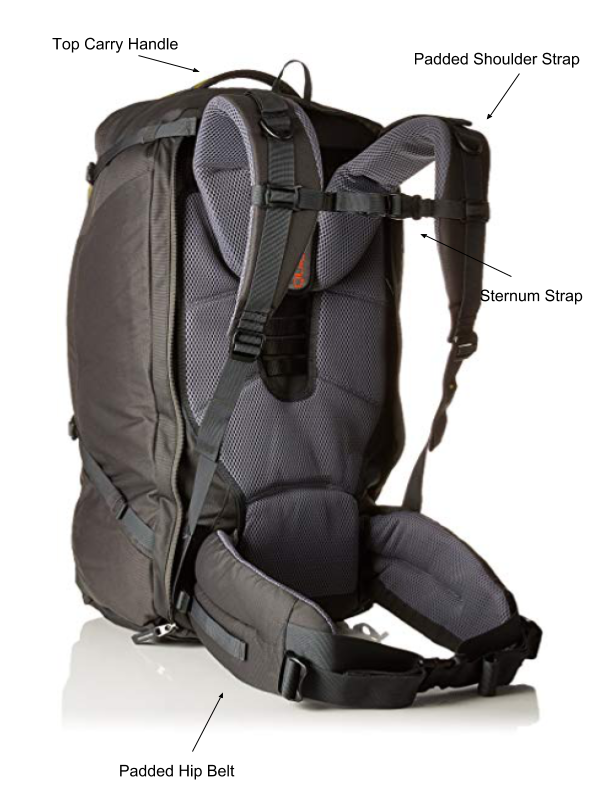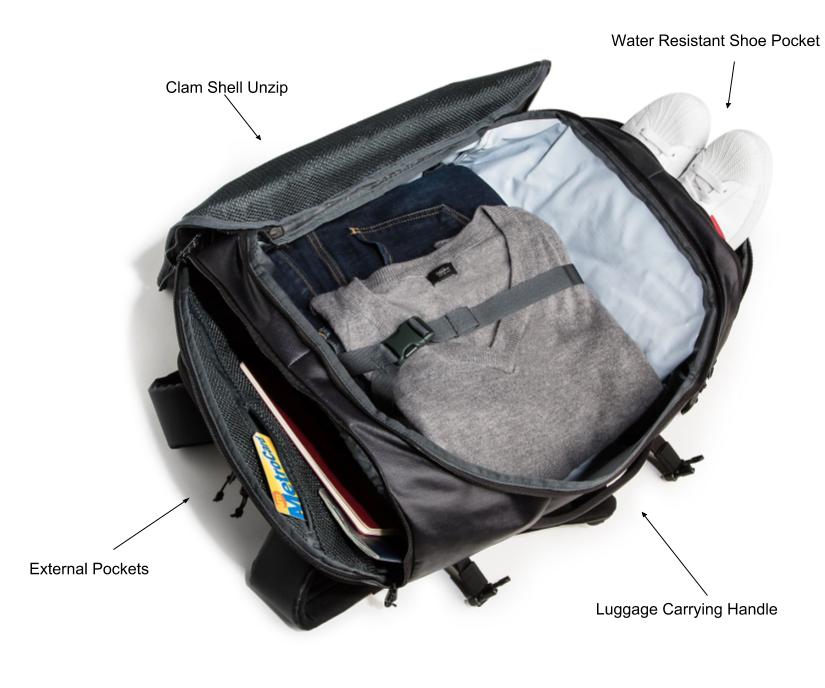Today’s high-tech backpack design… actually makes it hard to know how to choose the best travel backpack. Here’s what you need to consider when picking the right travel backpack for you.
Important Travel Backpack Features
There are four areas to consider when choosing a backpack:
-
Physical Comfort
-
Ease-of-use
-
Transit Mode
-
Security
Everyone has different needs in each category. To choose the right backpack for you, decide which features matter to you the most.

photo: mitchell griest
Physical Comfort for Travel Backpacks
For me, these are the most important backpack features to consider when choosing a bag. I’m a budget traveler. And a minimalist. I tend to walk long distances carrying all my gear, since there isn’t much of it. (Here’s what I pack.) There are three different features that affect how comfortable (or uncomfortable!) a bag is: bag capacity, support systems, and bag fit.
Bag Capacity
I’ve said it again and again – a small bag is your best friend!
Bag capacity – how much a bag holds – is measured in either liters or cubic inches. Here’s a video with some visuals to help you understand:
I don’t recommend anything larger than 50L. Really, I draw a hard line at 40L for anyone my size or smaller. For myself, I don’t like anything larger than 30L, which is the predominant size preference I’ve found among veteran travelers.
Small is so important. Especially if you’re going on a longer trip. All the days you spend comfortably carrying a small load make up for the day you “waste” tracking down, say, a rain jacket in the markets of Bangkok. Or learning to do as the locals do from the owner’s son you befriended at a noodle shop!
Support Systems
Especially if you’re considering a larger bag, support systems are critical. I look for padded shoulder straps, a sternum strap, and a hip belt.
Well-built shoulder straps keep the load from digging into your shoulders. A sternum strap helps distribute some of the load to your chest. A hip belt helps distribute some of the load to your hips and keeps the load close to your body. Every bag I own has all of these features.
Some backpack companies make ergonomically-designed straps for men and women. For example, the Osprey Fair View 40 is the women’s version of the Osprey Farpoint 40.
The Tortuga Homebase has hands down the best harness (shoulder straps + sternum strap) I have ever worn. This includes a comparison I’m making to the Ferrari of backpacks I was gifted several years ago. The Osprey porter 30 I’m currently using has a good, comfortable support system. (It also has the structural integrity I like in a bag.)
Finally, if you are prone to heat discomfort, look for a travel backpack that provides air circulation between your back and the bag.
Bag Fit
Backpack capacity (the number of liters it will hold) has nothing to do with how the bag fits your actual body. Most travel backpacks are one-size-fits most. Some come in sizes – generally small, medium, and large. In this case, it’s the length of your torso that determines your personal backpack sizing. (Your torso is what you’d have leftover if you got rid of your head and limbs. REI has a great guide for measuring your body.)
Torso ranges can be something like:
XS: 0-39cm (0-15in)
S: 40-45cm (16-17.5in)
M: 46-50cm (18-19.5in)
L: 51cm+ (20in+)
Backpacks aren’t like shoes. All of the packs I’ve reviewed come with adjustable features to accommodate torsos within a range. Learn about these features once you own a bag. Having them dialed in is downright luxurious.
Ease-of-Use for Travel Backpacks
Basically, this category is about how you interact with your bag. For me, these are the second most important backpack features to consider when choosing a bag. If the packing accessibility, compartments, or external access suck… it will subtly, slowly drive you bonkers!
Packing Accessibility
You’ll hear things like top loader and clamshell and unzips like a suitcase thrown around a lot in the travel backpack world.
A top loader is a bag only accessible from the top. I traveled for years with a bag like this. I pack really lightly, so my top loader bag never really bothered me. However my last two bags have opened like a clamshell, also known as unzipping like a suitcase, and I love it. I’m super happy with the way my Osprey porter 30 keeps its shape, even when empty. When full, I can easily unzip and see everything in the bag at a glance.
Compartments
If you follow my advice to stay small, compartments won’t be an issue for you.
Once you start bringing more gear, it’s really nice to have a way to keep it all separate. Many bags come with a “shoe” compartment – which is really just a water-resistant compartment in the bag. It’s a great place to keep your dirty shoes most of the time. However, on, say, a rafting trip where you have no choice but to bring all your gear, you can put things like your passport and maybe double-protected electronics in this compartment.
I like my bags to have at least three sections – a main compartment, a secondary compartment where I tend to keep all the little gear from my packing list, and a front compartment where I stash boarding passes or sometimes use for storage of a specific category of items.
External Access
Being able to quickly take things in and out of your bag is clutch for me. However, as I’ll explain in the “security” section… if you can quickly take something out, a thief might be able to do the same. I love that my Osprey porter 30 has a stash pocket at the top of the bag that you can’t really even see unless you already know it’s there.
Consider what kinds of pockets there are, how many, and how they open. How easily can you take out things you need on-the-go? Your water bottle as you ride a tuk-tuk across a Thai city. Your book or tablet as you sit trapped in the middle seat on a 12 hour flight. Your phone as you try to find your hotel reservation. Your earbuds and sleep mask when it’s dark on an overnight bus in Argentina.
Transit Mode for Travel Backpacks
Your backpack is sometimes the thing you carry and sometimes the thing you get stuff in and out of. When it’s being the thing you carry, how it interacts with the environment around you can be really important.
Whether or not your bag fits within carry on limits and how gangly it is make a big difference getting on and off airplanes, trains, busses, etc.
Carry-On Limits
If your bag doesn’t fit within carry-on limits, you’ll constantly be paying the price both of checking a bag and waiting at the luggage carousel while all the carry-on-only people snap up the last rooms in the town.
The trick is… carry-on limits aren’t fixed. They vary from airline to airline and country to country. I love getting to fly in the U.S. as carry-on limits in America tend toward generous. In other places, especially on low-cost carriers like JetStar, AirAsia, and RyanAir, I am always chewing my fingernails about meeting the limits. The worst is that even if your bag is the right size, in some places it also has to be a certain weight. Sometimes you just have to suck it up and pay baggage fees.
Compression
Compression straps come on many bags. They serve two purposes in my mind. First, to make the bag smaller. Second, to make the bag tidier.
Smaller matters when you’re trying to fit within size limits or into the overhead bin on a bus. Tidy matters when you’re trying to get through turnstyles without getting hung up or be seen favorably by immigration officials. When cinched down tight, compression straps sometimes keep contents from moving and move a load closer to my back for increased ergonomic comfort.
Instead of using them to compress, compression straps can also be used to attach things to the outside of your bag. A towel or sarong that hasn’t finished drying, a hammock that you bought for a trip down the Amazon by hammock-boat, etc.
Suitcase Mode
I have to say this feature has never mattered much to me. Suitcase mode generally refers to the ability to tuck away the shoulder and sternum straps and the hip belt. Once tucked away… wahlah! You basically have a suitcase. If you’re going to end up checking your bag occasionally, it can be nice not to sent your bag into the bowels of baggage handling machines with a bunch of dangling straps.
If you’re getting anything bigger than a 30L bag and plan to fly on budget airlines, and hope you’ll be able to squeeze under carry-on limits, I can definitely advocate getting a bag that converts to suitcase mode for the inevitable time or two that you’re suddenly forced to check it.
Marketing materials will have you believe that suitcase mode is also excellent when flying carry-on. I’m sorry, but I’ve never had my bag in suitcase mode in these scenarios and been glad for it. It’s not comfortable to lug around a heavy bag with no wheels when it could be strapped to your body. Just my personal experience.
Security for Travel Backpacks
There are two things most people want to keep their bags safe from – the elements and other humans.
In our era of electronics, water resistant features matter lots to certain wanderers. Among the reality of haves and have-nots, thief resistant features often matter to some travelers.
Water Resistance
When it comes to keeping water out, there are a few things to consider. The material used for bag construction may be water resistant. The zippers may be water resistant or designed in such a way that water is repelled.
When it comes to keeping water contained – think wet shoes, a swimsuit that you can’t dangle from your bag in transit, etc – a water-resistant compartment comes in handy. Water-resistant compartments also come in handy when you have to have all your gear with you and your bag is exposed to the elements. Rafting, the bag being strapped to the roof of a bus in a rainstorm, etc.
Lockable Zippers
Zippers are considered “lockable” when they have metal loops through which you can slide a small lock. E.g. most zippers in the past. These days, it’s become more common for cloth, rubber, or plastic to be attached to the piece of metal that joins and separates the zipper teeth.
In my mind, a fabric or plastic loop is still lockable, but it’s true that it’s easier to cut those materials (compared to metal). However, I think anything joining the loops together – from a twist tie to a rubber band to a piece of string – will help deter an opportunistic thief.
Opportunistic theft supposedly accounts for the majority of thefts. E.g. the person didn’t set out to steal someone’s wallet, but it was… just sitting on a table. Or, e.g. the person didn’t set out intending to take your smartphone from your bag, but there it was, unlocked and unsupervised.
Bottom line – I almost never lock my bag. When I do, I use whatever the bag has… fabric, plastic, or metal loops. So far (15+ years of travel), no regrets!
Extra Security Features
Did you know your identity and financial information can be stolen without your wallet leaving your sight? Have you ever heard of slash-and-grab? Forget pickpocketing… just cut a bag open, reach in, snatch the goodies, and run!
I have never, in a decade and a half of travel through dozens of countries, ever been pickpocketed, slash-and-grabbed, or had my identity stolen. I’m careful and aware. But if you’re not, or you’re just an extra-cautious person, consider a bag like the Pacsafe Vibe 40L with extra security features like an RFID-safe pocket, knife-resistant metal webbing built into the fabric, built in bag-leash, and other theft-resistant details.
Final Travel Backpack Thoughts
There is no official “best travel backpack.” There might be a best travel backpack for you, though!
Make some decisions about which features – comfort, use, transit, and security – are more important to you.
Then check out reviews of the Top 15 RTW Backpacks.
For help packing check out my RTW Packing list.







Twitter Facebook Google+ StumbleUpon Reddit Pinterest